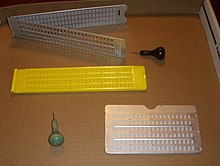
The slate and stylus are tools used by blind people to write text that they can read without assistance.[1][2] Invented by Charles Barbier as the tool for writing letters that could be read by touch,[3] the slate and stylus allow for a quick, easy, convenient and constant method of making embossed printing for Braille character encoding. Prior methods of making raised printing for the blind required a movable type printing press.
- ^ Alpha Chi Omega (1908)
- ^ Shrady, et al.(1902)
- ^ Note: Different references assign invention of the slate and stylus to either Barbier or Braille. However, Braille (1829) credits Barbier with the invention. Barbier's slate consisted of six slots; Braille reduced it to three, as his cells were only half the size of Barbier's. When dashes were removed, the slots were no longer needed in full and were replaced with pairs of dots.
© MMXXIII Rich X Search. We shall prevail. All rights reserved. Rich X Search
